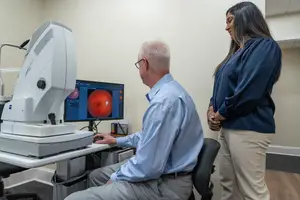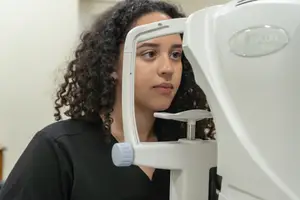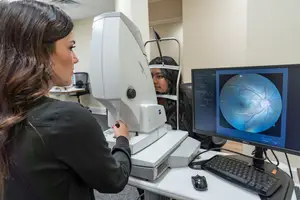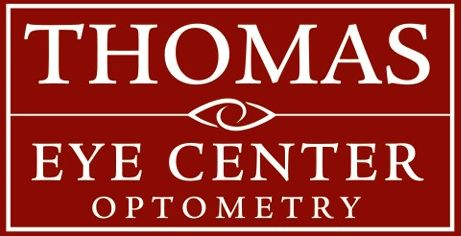Eye Disease Management at Thomas Eye Center
Ongoing care and early detection can help preserve your vision and protect your long-term eye health.


Why Monitoring Eye Health Matters
Some of the most serious eye conditions develop slowly and without obvious symptoms.
Regular monitoring allows us to detect changes early, track risk factors, and provide care before vision is affected.
We take a proactive, long-term approach to disease management in Athens, so patients feel informed, supported, and confident in their care.
Eye Conditions We Monitor & Manage
We provide care for patients managing a variety of chronic and age-related eye conditions, including:
Glaucoma: A group of conditions that increase pressure in the eye and damage the optic nerve. Often symptomless in early stages, glaucoma is one of the leading causes of vision loss in adults. Regular testing helps us monitor pressure, evaluate nerve health, and recommend treatment when needed.
Diabetic Retinopathy: High blood sugar can damage the blood vessels in the retina, leading to vision loss if not detected early. We provide diabetic eye exams that include retinal imaging and dilation to monitor for changes and coordinate care with your primary physician if needed.
Age-Related Macular Degeneration (AMD): A condition that affects central vision and can make reading or recognizing faces more difficult. We track changes in the macula using imaging tools and help patients understand lifestyle changes, supplements, or referrals that may support long-term function.
Ocular Hypertension and Risk Factors: For patients with higher-than-normal eye pressure or a family history of eye disease, routine monitoring helps us stay ahead of potential changes and begin treatment early if necessary.

What to Expect During a Disease-Focused Exam
These visits are more detailed than a basic vision check. Depending on your condition or risk factors, your eye exam may include:
Intraocular pressure measurement
Visual field testing
Retinal imaging and optic nerve evaluation
Optical coherence tomography (OCT)
Dilated eye exam
Monitoring for progression over time
Each visit includes time to explain findings, answer your questions, and adjust your care plan if needed. We focus on prevention, education, and communication at every step.
Tools & Technology That Support Your Care
We use modern diagnostic tools, including Zeiss OCT, visual field testing, and retinal photography, to detect and monitor even the smallest changes in your eye health.
These tools allow us to document your condition over time and personalize your care based on real-time data.
Concerned about your risk or managing an existing condition?Schedule a personalized eye health evaluation in Athens and get the clarity and support you deserve.

Your Partner in Lifelong Eye Health
Living with an eye condition can feel overwhelming, but you don’t have to manage it alone.
We’re here to provide steady, consistent care that fits your needs, with a clear plan, regular monitoring, and support that evolves with you.
Schedule an Eye Health Evaluation in Athens
If you have a diagnosed eye condition, a family history of disease, or just want to take a more proactive approach to your vision, we’re here to help. We provide disease-focused eye care for patients in Athens, Watkinsville, Jefferson, and surrounding communities.
